Let’s talk...
About different feelings: we can ask the child: Where is grandmother? Is she really present? How does the child in the story feel? What did she do to deal with her longing? Could there be other feelings the child has that aren’t shown in the story?
About similar experiences:we can ask the child: Have you ever lost someone or something dear to you? Do you miss them? What can you do when you’re missing them? In case of losing a grandfather or grandmother-let’s share beautiful memories together: what did we love to do together?
Let's observe...
The illustrations take us to the beautiful world that united the granddaughter and grandmother. Let’s examine the drawings and notice the items that passed from grandmother to granddaughter, and other items similar to what we see in our grandparents’ homes.
Let's communicate...
We can visit our grandmother or grandfather, tell them how much we love them, and together create an album or box of photos and items of beautiful memories with our grandparents.We can go to the sea together and collect different shells and stones.
Let’s explore...
We can think about the illustrations and try to guess which city grandmother’s house is in. We can recall other coastal cities in our country and learn about them.
Let’s talk...
About situations and feelings: we can ask our child: Why was the frog running away?How was he feeling? What was he thinking? What helped him? What did he need to stop running?
About experiences and new places: we can ask our child: Have you ever been somewhere new? How did you feel? How did you act? What helps you overcome anxiety and face challenges?
Let's explore and enjoy...
The illustrator used collage technique in the story’s illustrations. Let’s examine the drawing sand try to spot other creatures hiding in the picture. Let’s search for them and name them.
Let's research and explore...
Two types of frogs were mentioned in the story: marsh frogs and tree frogs. What’s the difference between them? What are the characteristics of each?
Let’s explore the different stages of frog development.
We can also visit the forest, valley, or nearby public park to observe different living creatures and try to imitate their sounds.
Let's play together...
Let’s practice our frog jumps, imagining our house floor is the marsh, then build a path using pillows and rugs as stations, moving between them as frogs do in the marsh.
Let’s talk...
What makes us grumpy? We can clarify with synonyms like dissatisfied, upset, resentful, irritated, sad, sulky, or in a bad mood.
How does my body feel when I’m grumpy? What about my facial expressions?We can share our experiences with our children and encourage them to share theirs.
What are things that help me calm down? For example: waiting a little, hugging, playing, talking to a friend, drawing, etc.
Let's research...
Let’s examine the illustrations to find clues about the bird’s feelings. We can observe how different colours express emotions.
Let's communicate...
We can play “Imitate My Move:” Each time the child makes a move, family members copy the child’s movements, adding new ones and taking turns.
Encouraging helping others: We can motivate our children to offer assistance, using phrases like “Do you want help?” or “Can I help?” We can also encourage them to take care of neighbourhood animals by providing water or food.
Let's discover...
We can observe birds in our garden or neighbourhood and research their names.
نتحاور
نتحاوَر حول:
المَشاعر: نتحدّث عن مَشاعر الفيل في مشكلته، وفي المَواقف المختلفة، ونلاحظها بعد مساعدة القرد له. نتحدّث عن مشاعر الحيوانات التي أربكَها سلوك الفيل. نتحدّث عن مشاعرنا المتوتّرة أو الغاضبة وسبُل التعامل معها دون تخريب.
ردود الأفعال: نلاحظ سلوك الفيل، وردود أفعال الشخصيّات. ننتبه لاستجابة الفيل لمساعدة القرد، وكيف ساهمت في حلّ المشكلة. نربطها بمواقف من حياتنا وخبراتنا الشخصيّة. كيف نعبّر عن مشاعرنا المؤلمة في الأزمات؟ كيف نساعد شخصًا في أزمةٍ أو ضائقة؟
الأزمات: ضائقة/ مشكلة/ أزمة- ماذا نعني بها؟ هل مررنا بمواقف مشابهة؟ نصفها ونستذكر مشاعرنا فيها. مَن ساعدَنا وكيف؟ هل ساعدنا شخصًا في أزمة أو مشكلة؟
خطوات مساندة: “أهدأ/ قف أرجوك أنا هنا لأساعدك”. هكذا منَح القرد الفيلَ أمانًا ليساعده في الحلّ. نتحدّث عن الخطوات التي تساعدنا في مواقف مربكة. قد نتنفّس ببطء/ نطلب المساعدة/ نجلس في ركنٍ هادئ/ نعبّر عن شعورنا ونسمّيه. ماذا أيضًا؟
البيئة: شكّل الكيس خطرًا على الفيل. نتحدّث عن مساهمتنا في المحافظة على البيئة والأحياء.
نُثري لغتنا
المفردات: نقرأ النصّ ونوضح معاني المفردات. نتعرّف على تسمية المشاعر المختلفة وكيفيّة التعبير عنها.
الأفعال:
نميّز الأفعال الحركيّة: ركض/ اندفع/ هزّ/ طارت/ تقدّم/ داس/ قفز.. نؤدّيها حركيًّا ونلاحظ أثرها. نقترح أفعالًا حركيّةً أخرى ونلاحظ الفرق بينها.
نميّز الأفعال الكلاميّة: صرخ/ تجادل/ تناقش/ تساءل.. نلاحظ الفرق بينها ونقترح ما يلائمنا للتعبير.
نميّز الأفعال الشعوريّة: شعر بالاختناق/ خاف/ ضايق/ غضب. نتحدّث عن المشاعر وإشاراتها في الجسد وتعابيرها في ملامحنا، وطرق التعبير عنها.
الصّفات: نلاحظ صفات فيلون في النصّ، مَن يشبه ممّن نعرف؟ نقارن بين لطفه مع أصدقائه وسلوكه مع المشكلة. نلاحظ صفات القرد وبقية الحيوانات. ماذا نستنتج عن كلّ منها؟
أسماء التحبّب: فيلون صيغة تصغير للفيل. ما هي الصّيَغ التي يحبّها أطفالنا لمناداتهم؟ نلاحظ الصيغ الصرفية الممكنة. قد نضيف للاسم مقطعًا أو نغيّر وزنه.
نلعب
ماذا في الصّورة: نجمع مجموعة صوَرٍ لمواقف حياتيّة، نتمعّن ونتعرّف على المشكلة فيها، ونقترح حلولًا ملائمة. (مثلًا: طفلٌ يبكي/ طفلان يتشاجران على لعبة/ طفلٌ سقط عن الزلاجة).
مَن أنا؟: تتّفق المربّية مع أحد الأطفال على أداء شخصيّة حيوانٍ ما. يقلّد الطفل الحيوان، ويكون على بقيّة الأطفال أن يعرفوه. نوجّه الأطفال إلى التعبير عن الحيوان بالجسد، ثمّ بالحركة، ثمّ بالصّوت.
نستكشف
نستكشف:
الغابة والحيوانات: في النصّ كثيرٌ من محتويات الغابة، ومختلف مواقعها وسكّانها. نبحث عن صوَرٍ ومعلوماتٍ عنها في الموسوعات والمَواقع. نستمتع بالتعرّف عليها وعلى بيئاتها وظروف معيشتها. قد نعدّ موسوعةً خاصّةً نضيفها إلى مكتبتنا، وقد نستعين بها لإنتاج غابتنا في ركن البناء.
نبدع
في بستاننا مسرح: نؤدّي مَشاهد من القصّة. كيف تتحرّك الشخصيّة؟ نلاحظ نبرة صوتها وطريقة تعبيرها. كيف يتحرّك الفيل والكيس في خرطومه؟ كيف تتساءل الزرافة عن حلّ؟ إلخ.
بستاننا أخضر: تسبّب الكيس بمشكلةٍ لفيلون. ماذا يقترح أطفالنا لاستحداث موادّ ومهملات بدلًا من رَميها؟ هل نقيم ورشةً للاستحداث ونُعيد إنتاج الموادّ بطرقٍ إبداعيّة؟ قد ننتج أيضًا مجسّماتٍ للحيوانات من الموادّ المستحدثة.
صندوق الأدوات للأزمات: نخصّص ركنًا صغيرًا في البستان، ونعدّ فيه صندوقًا لمساعدتنا في المواقف المزعجة. نفكّر معًا في أمورٍ من شأنها مساعدتنا في الأزمات، قد تكون جملةً نكرّرها عند الضيق :”أنا منزعج / غاضب/ مرتبك، لكن سأحاول أن أهدأ”. أو مقولةً داعمةً منّا نساند بها بعضنا، مثل: “أنا أحبّك/ أنا معك/ لا تقلق سأساعدك/ تعال نفكّر معًا”. نصغي إلى اقتراحات الأطفال ونضيفها في صندوق أدواتنا، ليلجأ إليها الأطفال عند الحاجة. (مثل: قراءة قصّة/ سماع موسيقى هادئة/ تأمّل صورة لمنظر طبيعيّ).
نتواصل
نتواصل:
نحافظ على البيئة: نفكّر معًا في طرق حماية البيئة والمحافظة عليها. قد نقترح مبادرةً لتنظيف مدخل البستان، أو تزيين البيئة بالنباتات. قد ندعو الأهل والأجداد لمشاركتنا في ورشةٍ خاصّة.
نساند بعضنا: نستضيف أخصّائيًّا في لقاءٍ مع الأهل، ونكتسب طرقًا وآليّاتٍ جديدةً للتعبير عن مشاعرنا، ولمدّ يد العون لمَن هم في ضائقة. قد نبادر أيضًا لمشروعٍ خيريٍّ لدعم المحتاجين في بلدتنا.
نتحاور
نتحاوَر حول…
المَشاعر: نتحدّث عن مَشاعر الفيل في المَواقف المختلفة. نستكشف مشاعر الحيوانات التي أربكَها سلوك الفيل، ونتحادث عن مشاعرنا المتوتّرة أو الغاضبة وسبُل التعامل معها دون تخريب.
ردود الأفعال: نلاحظ سلوك الفيل، وردود أفعال الشخصيّات. ننتبه لاستجابة الفيل لمساعدة القرد، وكيف ساهمت في حلّ المشكلة، ونربطها بمواقف من حياتنا العائليّة.
ضائقة/ مشكلة/ أزمة- ماذا نعني به، وهل مررنا بها؟ نصفها ونستذكر مشاعرنا فيها: مَن ساعدَنا وكيف؟ هل ساعدْنا شخصًا في مشكلة؟
خطوات مساندة: “اهدأ أرجوك، أنا هنا لأساعدك”، طمأن القرد الفيل. نتحدّث عن الخطوات التي تساعدنا في مواقف ضاغطة.
البيئة: شكّل الكيس خطرًا على الفيل. نتحدّث عن مساهمتنا في المحافظة على البيئة والأحياء.
نثري لغتنا
نُثري لغتنا
نقرأ النصّ ونوضح معاني المفردات. نتعرّف على تسمية المشاعر المختلفة وكيفيّة التعبير عنها. نتعرّف على الأفعال في النصّ، معانيها، أصواتها وحروفها. نلاحظها مع المذكّر والمؤنّث.
نتعرّف على الصّفات: نلاحظ صفات فيلون في النصّ، مَن يشبه ممّن نعرف؟ ما هي صفات كلّ فردٍ في عائلتنا؟
نبدع
نبدع
الصّندوق السحريّ: نفكّر معًا في أمورٍ من شأنها مساعدة الطفل في الأزمات، قد تكون مقولةً منّا مثل :”أنا معك وتعال نفكّر معًا”، أو غرضًا يحبّه، أو صورةً لعناقٍ يجمع عائلتنا. قد نضيف جملًا مطمئنة، مثل: “أنا أحبّك” أو جملًا يكرّرها الطفل لنفسه: “أنا منزعج /غاضب، لكن سأحاول أن أهدأ”، أو صورةً لمكانٍ طبيعيّ/ لشخصٍ يتنفّس بهدوء.
نجمع الأدوات في صندوقٍ، نزيّنه ونجهّزه للمَواقف المربكة. قد نتّفق أيضًا على ركن صغيرٍ في بيتنا يلجأ إليه الطفل عند الحاجة، نضع فيه الصّندوق، ليكون مخصَّصًا لتخفيف التوتّر وإعلان طلب المساعدة.
Let’s talk...
About plot: We can observe the details of the illustrations, and encourage our child to describe them, follow the events, and make connections. We notice changes in the sea scene, the girl, and the birds, describing the girl’s feelings each time.
About personal experiences: Have we experienced similar feelings? How and when? We can recall our journeys, adventures, moments, and various experiences.
About seas and nature: What does the sea remind us of? Which seas have we visited? What other natural places do we know? We can compare them: how are they similar or different?
Let’s enrich our Language...
Description and comparison: We can describe the girl’s features and the feelings she expresses. We can compare them in each scene.
Birds: We can pay attention to the birds in the drawings, think about their relationship with the girl, and learn about their characteristics and advantages.
Names: We can suggest a name for the girl, think about our own names, who gave them to us? We try to remember the stories and meanings behind our names.
Actions: We can observe the girl’s movements and name them. We can also perform similar actions.
Let’s explore...
Seas: we can visit a nearby sea, look at the sunset or sunrise, observe the waves, and enjoy the beach sand. We can look for scientific information: How are waves formed? What marine life lives in the sea and what distinguishes them?
Nature: We can choose a natural place for a shared We can visit it, appreciate its details, listen to the sounds, get to know the creatures, describe and play together. We may search the internet and encyclopaedias for information about the place before or after the visit.
Let’s create...
Paintings of nature: we can collect materials from nature during our outing and create paintings to decorate our home. (Paintings from seashells, mountain stones, or garden leaves).
Our book: we can document our moments with pictures and compile them into a book for the story of our enjoyable journey. What do we want to add to it?
Let’s talk...
About new beginnings: we can talk to our children about the feelings they had when they encountered new experiences such as their first day at school, a new class, or a friend’s birthday. We can explore ways that helped them adapt together.
About diverse experiences: The box captured for us rituals and family experiences, such as arranging winter clothes, playing in the courtyard, enjoying ice cream, preparing thyme pies (Manaquesh), and playing with the box. We can ask our child: Which rituals resemble those in our home, and which ones are different? We can describe them together.
Let’s play...
Let’s use our imagination and guess! We can sit in a group, and each person takes turns silently acting out an object (such as a cup, cat, lion, hammer), and others have to guess what this object is, and so on (time can be specified).
The magic of imagination: We can gather various objects (like hat, a pot, a scarf…) and explore diverse uses for the object, or imagine it as something else.
Let’s create...
Recycling: The book sheds light on the topic of recycling. We can also create a bag from old pants for example, or plant pots from pickle jars, etc.
Let’s enrich our language...
We can choose another object as the “hero” of the story, such as a bag or clothes, and we can creatively write a story about it from its perspective.
Let’s talk...
About experiences: We can follow the journey of the dinosaur and his friend Jojo, engaging with children about the places he visited, his behavior, his feelings, and the risks he This is an opportunity for us to accompany them on their journey and learn from their experiences.
About desires: We can talk about the places the dinosaur might want to visit and the activities he might want to do. We should encourage our child to suggest other places from their own experiences and ask them about the places they want to visit and the things they want to do.
Empowering the child and fostering a sense of capability and independence: We can discuss tasks our child can do on their own and those where they may need our assistance, along with their accompanying feelings. We can identify tasks or skills our child wants to learn, such as putting on shoes or making the bed, and support them in achieving those goals.
Let’s have fun and play...
“Where did the items hide?”: Let’s play the game “Hot or Cold.” We can hide the items and let the child search for them. We can guide them with the word “hot” when they are close and “cold” when they move away.
Let’s enrich our language...
We can enrich our child’s language and encourage them to describe what the dinosaur did during his visits to different places. We can use precise verbs and nouns, adding new qualities. For example, we might say, “a huge dinosaur, tall buildings…”
Let’s create...
A growth chart: we can choose a wall in the house and mark the child’s height on it. We can select pictures of our child at different ages and stick them in a long album, creating a growth chart from sturdy cardboard and decorating it. We can discuss our child’s abilities at each stage from birth to today and talk about things they would like to develop.
Let’s talk...
About feeling confused: With our child, we can discuss the mixed feelings of the monster. We can ask them: Why do you think the color monster woke up confused and excited? Have you ever felt this way?
About colors and feelings: The color monster chose a color that embodies her feelings every time. We can have a conversation with our child about colors and feelings and we can ask them: Which colors represent your feeling of joy? anger? Sorrow? What do you do when you feel this emotion?
About the connection between feelings and behaviour: With our child, we can have a dialogue and ask them: What changes in your body when you feel happy? angry? nervous? frightened? What do you do when you feel these emotions?
About the feeling of love: We can look at the drawings on the last page and search for an embodiment of the meaning of love. We can talk to our child and ask them: How do we feel that we are loved?
Let’s enrich our Language...
The book is rich in emotional vocabulary, which we may not use in the context of our spoken language. This generally limits our ability to express our feelings and even our awareness of them. We can include the use of emotional vocabulary in our daily lives to enrich our child’s ability to be aware and express feelings.
Let’s create...
We can prepare a jar of feelings with our children, and we can include it as a ritual in our daily schedule, so that every day we can choose colorful cards that embody our feelings during the day: I felt happy when… I felt angry when… I felt nervous when… Then we can discuss those feelings together.
The drawings in this book adopt the technique of collage. By using scraps of paper and newspaper, we can prepare various faces and paintings with our children. These could be funny, happy, sad, or angry.
Let’s communicate...
With our child, we can choose a daily “meditation” ritual that helps us relax, be aware and listen to our feelings, and relieve stress when we are angry or afraid.
Let’s talk about...
Behaviours and actions: We can follow the different situations in the text and talk about the behaviour of each of the parents and the child. We can ask our children: Why do you think the child behaved in this way? What is meant by the word “because?” What was the parents’ reaction at the beginning of the story? And how did their behaviour change at the end? How did the child’s behaviour change, and why?
Feelings: We can follow the different situations in the text and the drawings and talk about the feelings of both the parents and the child. We can ask our children: How does the child feel in different situations? How do the parents feel? Why do they think the parents felt this way? How did the child’s feelings change at the end of the story, and how did the parents’ feelings change, and why?
Life situations: The parents repeated the question “why” in many life situations, and Nadim’s answers were repeated with the word “because.” We can talk with our child about similar situations that occurred between us. We can ask them: How did you feel? Together, we can suggest alternative ways of approaching and communicating.
Let’s explore...
The word “why” is used to express protest. Together with our children, we formulate questions aimed at raising their curiosity and increasing their knowledge, such as: Why is the sky blue? Why do we eat? Why do we sleep? Why are colours created in nature? We can search the Internet and encyclopaedias for answers.
Let’s communicate...
Nadim did a lot of things on his own. We can look for a joint activity to do with our children in the family, such as: preparing a common meal; playing together…
Nadim expressed himself each time with the word “because.” We can also express and explain our actions, replacing the word with explanatory sentences in different situations.
Let’s imitate and act...
We play a role-playing game together. We can choose a life situation or an event in the story, and we act it out with our children. In this case, we switch the roles of the original situation so that the child plays the role of the parent, and the parents play the role of the child. We can replace the word “because” with our interpretations and our mutual dialogue.
Let’s talk...
About feelings: Tilda was happy at the beginning of the story, and suddenly she felt upset and anxious, and her feelings were reflected in the drawings. We can follow the drawings and ask our child: How does Tilda feel? Why did her feelings change? How were her feelings reflected in the drawings? Did you ever feel down? how did you feel? Who supported you?
About sources of strengths: Tilda felt happy at the beginning of the story. We can ask our child: What are the things that make Tilda happy? What are the things that make you happy? We can share life experiences in which we felt failure and despair with our child. We can talk about the things that helped us overcome them, such as talking to people who are important to us and relying on memories of interesting experiences in our lives.
About sources of strengths: Tilda felt happy at the beginning of the story. We can ask our child: What are the things that make Tilda happy? What are the things that make you happy? We can share life experiences in which we felt failure and despair with our child. We can talk about the things that helped us overcome them, such as talking to people who are important to us and relying on memories of interesting experiences in our lives.
Let’s try and achieve...
We try so we can achieve more: With our child, we can identify a number of goals or challenges that they want to achieve, with a set time period. For example, having goals for household chores, such as: making the bed or organizing the closet at a record speed; commitment to throwing out the garbage; Cleaning the table – and other goals they may want.
Let’s enrich our language...
We can enrich our children’s emotional dictionary with motivating words that we adopt in our dialogues with them, such as: be strong; continue in this way; you did well; amazing; Blessed are your efforts; Be what you want to be; be as you will; you are brave; you’re great.
Let’s explore...
Tilda learned a lesson from the little ladybug. We can look at one of the living creatures around us with our child. Which ones can we learn specific skills or qualities from, that may motivate us to keep trying?
Let’s create...
With our children, we can bring cards on which we write words of encouragement, or we record the things that our children can do and make them feel empowered and happy, and put them in a jar. Children then can read a card every day, to instill in them a sense of ability and strengthen their emotional immunity.
Let’s talk...
-About the girl’s feelings: We read the story with our children several times. We then follow the drawings and discuss them as an expressive artform and talk about the feelings of the girl in the different stages: when she prepares to go out for a walk with her father; when she is with the teddy bear; when she is with the animals of the forest; and at the aquarium with her father.
-About relationships with family: The girl talked about experiences and pleasant times she spent with her father and her doll in the winter. We can talk with our children about the common adventures and activities that we have done, and that they would like to do with us and with their siblings.
-About support and reciprocal relationships: the girl said that the father and the doll support her in difficult times and encourage her, and that they need her. We can talk with our children about the meaning of difficult times, and ask them: How did the father and the teddy bear need the girl? How do we encourage others in difficult times? Did you have a hard time? How did you deal with it? Who supported and helped you?
-About dolls and favorite objects: We can talk to our child about his/her favorite object. The girl played with her teddy bear, and he helped her discover new things and build new friendships, and so she was creative with her imagination and her play. We can ask our children: What do they like about their object/toy? And how do they play with it?
Let’s enrich...
-Let’s enrich our emotional linguistic dictionary: Several vocabulary describing different needs and different emotional states are mentioned in the book. We can have a conversation with our child about their meanings and what they signify. For example: What is meant by the words “protect me?” When are things difficult, and what does that mean? encourage me? Does someone need me? When do we feel the need for encouragement? It is important to relate the vocabulary to the context and the lived experience. For example, our child can apply them to talk about their own lives.
We make hats...
-We make hats: The text and the graphics suggested that the Big Bear was actually a bear because of the hat, and we were surprised to find out otherwise. With our children, we can bring different hats, such as a hat that looks like a rabbit, a rooster, and other animals. We can then let our imaginations run wild and play different roles while wearing those hats.
We can go out...
-The father carried his daughter on his shoulders, and went out for a walk in the nearby ocean. We can go out with our children for a walk in the nearby ocean. We can explore, play with them, and have fun!
We can chat...
We can chat with our child about an item they have been keeping for years. How did they get it? What is special about it? We can also talk about a cherished item that was lost. What do they remember about it?
We may want...
We may want to talk to our child about an object that has been passed down from generation to another, such as a dress, a piece of jewelry, or a tool at home. What does it mean to us?
This is an opportunity...
This is an opportunity to talk to our child about an experience of loss that they went through. How does he/she feel? And what can help them overcome feelings of longing and sorrow?
We can talk...
Sophia had wonderful times with her friend, teddy. We can talk about our friends, and what we would like to do with them.
We can encourage...
We can encourage our child to imagine what teddy went through on his long journey. They may want to tell us. We can help them write as they draw teddy’s trip along the seas and rivers. This activity prepares the child for writing a diary at a later stage.
We can visit...
We can visit the beach with our family. We can search together for objects we find, and imagine their owners. Our child may want to write a letter that s/he puts in a bottle and throws into the sea. Who knows? Someone might find it one day.
We can read...
We can read advertisements in the book about lost things. Which ones did our child love? It is enriching for our child to read the ads posted in the streets, as the child’s exposure to the printed graphic symbols will make it easier for him/her to learn to write and read letters later.
We can stop...
We can stop at the title of the book and talk about the name of the game in our local dialect (there may be other names for the game in other areas: cat-and mouse, for example). How do we play it? Do we know other games where players have to hide?
Heidi is hiding...
Heidi is hiding in her special and unique way. We can talk about the difference between the way Heidi hides, and the way our child knows how to hide.
We can look...
We can look at the drawings together and try to find Heidi in every drawing. How did she hide in each?
Heidi forces her...
Heidi forces her friends to play hide and seek, and she always wins. How could her friends feel?
We can talk...
We can talk with our child about a game that they like to play with their friends in kindergarten and which they excel at. Which games do their friends excel at?
What happens...
What happens in our family? It would be fun to spend the day off playing games that family members love.
This book is...
This book is distinctive in terms of its artistic features, as each drawing uses several drawing techniques, including printing. This is an occasion for our child to test hand-printing with different tools. All we need is: A piece of cardboard A plastic plate Thick colored paint (like finger paint) Printing tools, such as: a piece of corn or potato, a sponge cut into different shapes, and ready-made printing tools.
We can stop...
We can stop at the drawing of the child after his tower had collapsed. We can talk about how the child feels at that moment. What parts of the drawing tell us how he feels?
We can recall...
We can recall the animals’ reactions. How did each animal try to help the child? If we were in the child’s shoes, would we accept the help of one of the animals? which one would it be?
The rabbit helped...
The rabbit helped the child by listening to him, as he was expressing his anger, sadness, frustration, and his desire to build a new tower. With our child, we can look at the drawings of the rabbit, in each one: How did the rabbit’s body language show that he was listening to the child? (He stayed close to him, grabbed his hands, looked at him, searched for him under the box …)
We can talk...
We can talk with our child about a similar situation they went through, in which they felt sad or angry. We can try to remember what helped them calm down and start over. We may notice that our child resorts to their doll, especially the one with soft fabric, to convey their feelings – which is a normal behavior for kindergarten children – but it does not substitute our presence next to our child, and our sympathy for them.
With our child...
With our child, we can recall an experience they went through in kindergarten or at home, in which they supported a friend or a grieving relative. This is an opportunity to explain to our child the importance of being compassionate and supportive of others. We may wish to share a personal experience with our child, with family members, friends, and co-workers.
Do we have...
Do we have wooden cubes or empty plastic boxes in our house? Let’s have fun building a model with our child. If it breaks down, it’s okay, we can always build a new one, and it will definitely be cool!
We can look...
We can look together at the drawings on page 5. How do Russel and his family get ready for bed? How do we, in our family, prepare for sleep? Together, we can look at the page before last in the story as the sheep wake up in the morning. How does each sheep start its day? How do we start the day at home?
We can chat...
We can chat with our child about the importance of sleep. What happens if our body does not get enough rest?
Sometimes our child...
Sometimes our child, and even us adults, find it difficult to fall asleep. What can help us? (Maybe we can read a book, hear a story, or have a warm drink…)
Russel has a special...
Russel has a special cute hat he wears to sleep. With our child, we may want to design a special hat for them to wear when getting ready for sleep. We can search our closets for an old hat and decorate it with our child in a creative workshop!
The sheep live...
The sheep live in “Frogfield,” the home of frogs. Imagine what the name of the field would be if rabbits lived there, or maybe cats.
While trying to fall...
While trying to fall asleep, Russel “takes off” his wool, so he starts to feel cold. Which things in our house are made of wool? This is an occasion to talk with our child about the wool’s “journey” from the sheep to our homes.
Russel counts up...
Russel counts up to six million and ten! Let’s try to count together: one…two…three…
Many children feel...
Many children feel anxious when they start first grade. The must get used to many new things. It is important to talk to children about anxiety over school, and discuss what can help him. He can draw his own parachute and write down what helps calm his fears.
The illustrations depict...
The illustrations depict different angles to express Toby’s feelings in each one. It would be nice to try to take pictures of things from different angles, such as taking picture of inside a car, taking picture from a high point, low point, and see what we can understand from the picture?
We can chat...
We can chat with our child about things that make them afraid. We can encourage them to talk about everything: What exactly frightens them, and which feelings do they experience physically at that moment?
People differ in...
People differ in their physical reactions in situations of fear, some of them become irritable, sweat and feel hot, and others feel paralyzed, or they may feel cold. It may be helpful to share what scares us with our child, and how we physically feel in moments of fear.
What can help...
What can help us relieve our fear in each situation? Together, we can think of practical ways that suit our child’s abilities, such as asking for help, breathing deeply, or turning to someone they trust.
Often, when we...
Often, when we materialize the source of our fear, we feel that we are in control of it, and this reduces the severity of its impact on us. We can encourage our child to draw what they are afraid of, or to shape it with playdough.
We can look...
We can look together at the last page of the book, where it has all the animal pictures: we can recall with our child the name of each animal and why it is hard to bring them home.
Encourage the child...
Encourage the child to think of an animal that was mentioned in the book and imagine together what we need to change in the house to make it livable for that animal (make a hole in the ceiling so the giraffe can stand straight…)
We can have...
We can have a conversation about other animals, that are not mentioned in the book, and discuss whether it is hard to keep them in the house and why.
If you have a pet...
If you have a pet at home, you can have a conversation about it, what the child loves about it and what is needed to take care for it.
We can imagine...
We can imagine that the dog in the story dirtied the house, and the parents did not like at all. Suggest to the child, what other animals she can raise in the house.
We are hosting...
We are hosting the animals! Maybe we want to make masks of animals faces and give each member of the family one and ask them to imitate the animal’s voice and way of moving. All we need is to draw the animals face and sticks.
We can follow...
We can follow with our child what caused the color of Pete’s shoes to change every time: the strawberry changed it to red, blueberry to blue … we can suggest different colors, such as orange and black, and encourage him to think what might change Pete’s shoes color to these colors.
We can encourage...
We can encourage our child to think of different objects that Pete might step on. What color would they turn his shoes?
We can go...
We can go to take a look at the shoes in our closet and check: which one is dusty, ruined, or has stains or scratched? Where did we step on our way that caused the shoes to look like this?
Despite the fact...
Despite the fact the Pete adores his white shoes, he is quite happy with every new color. Can we can recall similar incidents that happened with us: perhaps a piece of furniture that was used for a new purpose when it got old.
A fabric dye...
A fabric dye workshop! Your child might enjoy experiencing dying cloths with different colors. We can use organic materials such as boiling turmeric.
We can continue...
We can continue the scenes of the book with our child: we laugh a lot when… we can act or imitate different actions that cause the child to laugh such as, tickling, or piggy back rides.
We can have...
We can have a conversation about things that make our child laugh, at home, in the street and in class. We can encourage him to draw these things, and we write it down using his language.
What makes...
What makes every family member laugh? We can encourage our child to conduct a “small research study” to see what family members find funny, and to imitate everyone’s laugh in the family.
We can search...
We can search together the child’s library, and find books that make him laugh. Maybe read those books again together, or maybe watch a funny movie together
“Freezing” is a fun game...
“Freezing” is a fun game. The participants wander around in the room as music plays, but when it stops every player freezes and a player, “the clown” should try to make everyone else laugh with facial expressions — and without touching the “frozen” players.
Talk with your child...
Talk with your child about an enjoyable activity that he/she likes to do with other children, and one that is unique for him/her. You might want to share with him/her an activity that you enjoy.
Rabbity disappears suddenly...
Rabbity disappears suddenly. Discuss what might have happened to him, and what did this make his friends feel.
The absence of...
The absence of a dear person from a child’s life can be a difficult emotional experience, but one that each child goes through as part of life. This book might arouse painful memories and feelings for loosing someone dear. But it’s an opportunity to encourage your child to express feelings of sadness, anger, as part of positively dealing with loss.
Rabbity left his...
Rabbity left his colors and musical instruments for his friends to enjoy, create and remember him in joy. You might want to collect with your child nice memories of a dear person: A picture album, a book about funny memories that you can help your child write and illustrate.
“Family hobbies day”!...
“Family hobbies day”! Where each one invites others to share a favorite activity.
The illustrator plays...
The illustrator plays with paint spots to do the illustrations. Your child will enjoy blowing with a straw on a small amount of paint on a paper, to get a colorful painting or a background for his/her drawings.
Dry leaves in...
Dry leaves in a closed plastic bag, or dry peas in a closed yogurt container can make wonderful musical instruments to enjoy making a concert with your child!
You can have...
You can have a conversation with your child regarding Duna’s behavior at home and at the kindergarten: Why does she refuse what is given to her? Or asked to do? You can also talk about Duna’s feelings in these situations.
You can bring...
You can bring two cards, one with a smiling face and the other with sad face. You can ask your child to choose randomly one card and to ask him/her what he/she always wants or doesn’t want. You can let your child ask you the same questions in order to make things clear about accepted behaviors in the family.
You may choose...
You may choose one issue or problematic aspect of your daily life with your child – something that he/she always refuses to do (such as, to arrange his stuff or to take a bath etc..) and act it out together, encouraging your child to express feelings about rejecting things and suggest alternative solutions to decrease the intensity of his rejection.
You can make...
You can make a deal with your child, to let him do things which he likes, but on the other hand, to forbid him from doing harmful things such as playing on the street.
Talk with your child...
Talk with your child about what he/she feels similarly to the cloud in the books. Do they have things in common? What?
The cloud enjoys...
The cloud enjoys moving above different places. If we were a cloud where do we want to go?
The cloud feels...
The cloud feels lonely when its parents hang out at night, so she spends time with her cloud friends. We can talk with with our child about his/her feelings when we are away, and think together about things that can help our child feel secure (such as talking on the phone, or staying with a person he/she loves and feels comfortable with).
The cloud is happy...
The cloud is happy to play with its friends. What do we like to do with our friends?
In Autumn...
In Autumn the sky is full of different shapes of clouds. It would nice to lay down in the garden and watch the clouds. What shapes do we see?
Clouds in our house!...
Clouds in our house! We can look for materials at home which can help us making clouds: such as, cotton balls, shaving soap and can add food coloring to make colorful clouds!
Have a conversation...
Have a conversation with your child about their new experiences at the kindergarten: For example, you can ask: Did you learn anything new? What makes you happy to go every morning to kindergarten? Does anything confuse you or upset you?
We can have...
We can have a conversation with a child about the things they would like to take from home to the new kindergarten, such as a toy, or people to come along. Is it possible, and what are the alternative solutions in case it is not?
Remember things...
Remember things we love to do together: such as the whole family going to a picnic, reading a book, or making a favorite cake together.
People express...
People express their happiness in different ways: some sing, some dance, and some give a hug to people they love. We can have a conversation about the ways we express our happiness, and think of other family members or friends, and enjoy imitating their ways to express happiness.
Happiness wings...
Happiness wings workshop! We have a conversation about things that make us happy, so we feel we are flying like the child in the story. We might want to support our child to draw what makes him happy, or by using play dough. We design together wings and stick on it what makes us happy and fly.
When the child...
When the child sat on her fathers’ shoulders, she saw the world differently from above. What does the child see if they sit on our shoulders? How does their neighborhood look if we look together from the house roof top?
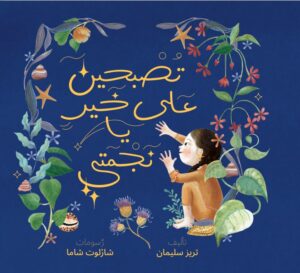 Good Night, My Star
Good Night, My Star 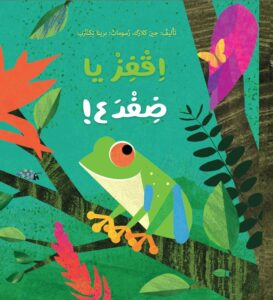 Jump, Little Frog!
Jump, Little Frog! 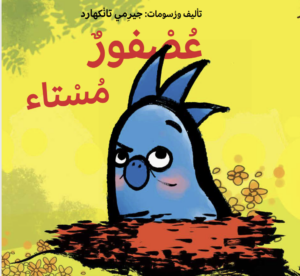 Grumpy Bird
Grumpy Bird 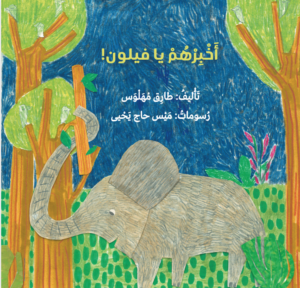 Fayloon
Fayloon 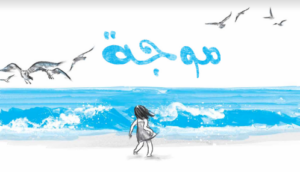 Wave
Wave 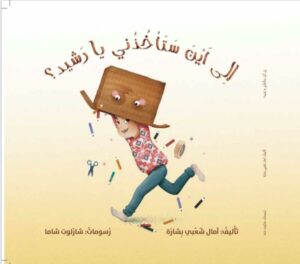 Where will you take me, Rashid?
Where will you take me, Rashid? 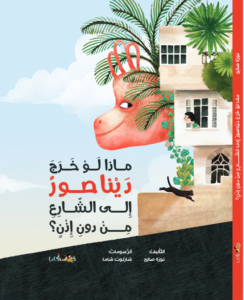 What if the Dinosaur Went Out to the Street
What if the Dinosaur Went Out to the Street 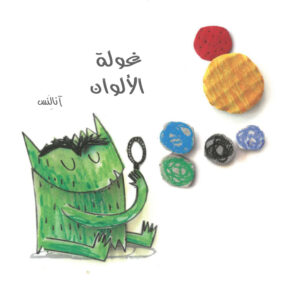 The Color Monster
The Color Monster 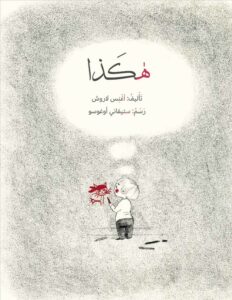 Because
Because 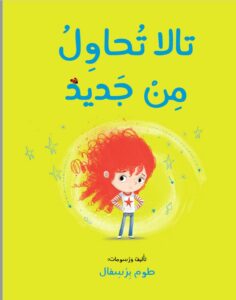 Tilda tries again
Tilda tries again 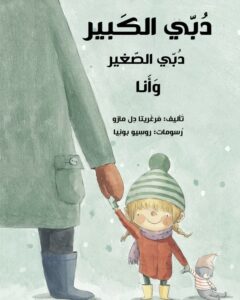 My big bear, my little bear and me
My big bear, my little bear and me 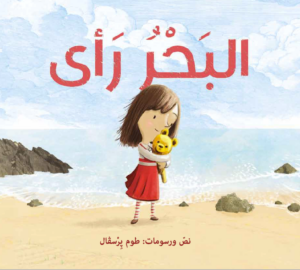 The Sea Saw
The Sea Saw 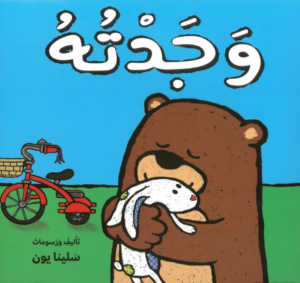 Found
Found  Hiding Heidi
Hiding Heidi 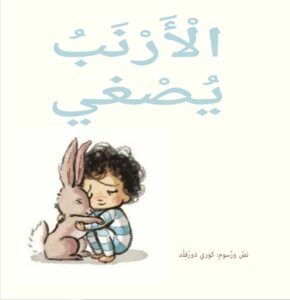 The Rabbit Listened
The Rabbit Listened 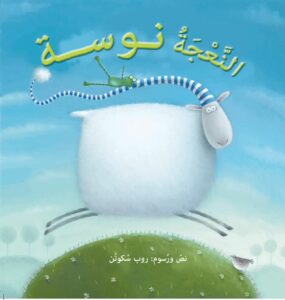 Russel The Sheep
Russel The Sheep 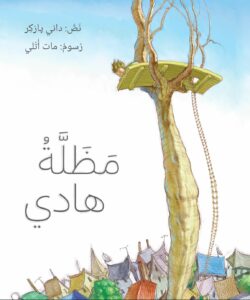 Parachute
Parachute 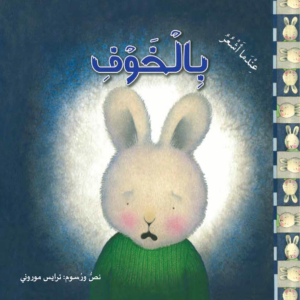 When I’m feeling scared
When I’m feeling scared 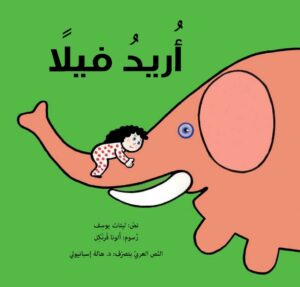 I Want an Elephant
I Want an Elephant 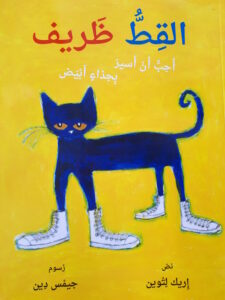 Pete the Cat- I Love My White Shoe
Pete the Cat- I Love My White Shoe  How Much I Laugh!
How Much I Laugh! 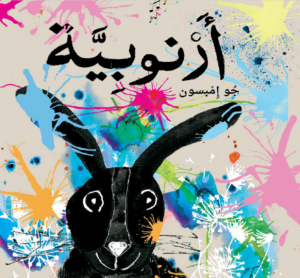 Rabbityness
Rabbityness 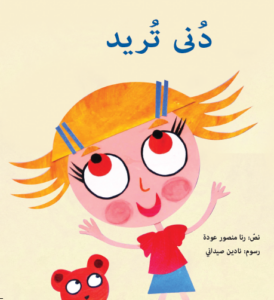 Duna Wants
Duna Wants 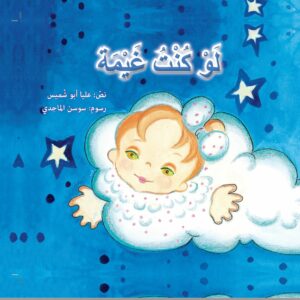 If I Were A Cloud
If I Were A Cloud 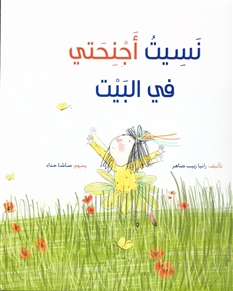 I Forgot My Wings At Home
I Forgot My Wings At Home 
